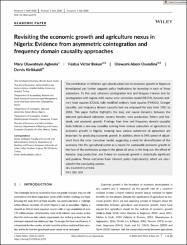Revisiting the economic growth and agriculture nexus in Nigeria: Evidence from asymmetric cointegration and frequency domain causality approaches
Özet
The contribution of different agricultural subsectors to economic growth in Nigeria is
investigated and further suggests policy implications for investing in each of these
subsectors. To this end, Johansen cointegration test and Gregory–Hansen test for
cointegration with regime shift, vector error correction model (VECM), dynamic ordinary least squares (DOLS), fully modified ordinary least squares (FMOLS), Granger
causality, and frequency domain causality test are employed for data from 1981 to
2016. This paper further highlights the long and causal dynamics between the
selected agricultural subsector, namely forestry, crop production, fishery and livestock, and economic growth. Findings from time and frequency domain causality
tests indicate a one-way causality running from various subsectors of agriculture to
economic growth in Nigeria, meaning how various subsectors of agriculture are
important for predicting economic growth. In addition, there is 54% speed of adjustment from the error correction model, suggesting a need for diversification of the
economy into the agricultural sector as a means for sustainable economic growth in
the face of the continuous plunge in the global oil price. In the long-run, the effect of
forestry, crop production, and fishery on economic growth is statistically significant
and positive. These outcomes have inherent policy implication(s), which are elucidated in the concluding section.
Cilt
22Sayı
1Bağlantı
https://hdl.handle.net/11363/5575Koleksiyonlar
Aşağıdaki lisans dosyası bu öğe ile ilişkilidir:


















